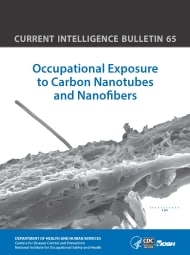CIB No. 65 " provides model recommendations that will support the safe growth of nanotechnology as scientists continue complex research to fully understand its occupational safety and health implications. In this way, we advance beyond the 20thCentury practice of introducing new materials into the workplace and only later, as an afterthought, considering questions of worker risk. "
===
[... ] Occupational exposure to CNTs and CNFs can occur not only in the process of manufacturing them, but also at the point of incorporating these materials into other products and applications. A number of research studies with rodents have shown adverse lung effects at relatively low-mass doses of CNT and CNF, including pulmonary inflammation and rapidly developing, persistent fibrosis. Although it is not known whether similar adverse health effects occur in humans after exposure to CNT and CNF, the results from animal research studies indicate the need to minimize worker exposure.
This NIOSH CIB, (1) reviews the animal and other toxicological data relevant to assessing the potential non-malignant adverse respiratory effects of CNT and CNF, (2) provides a quantitative risk assessment based on animal dose-response data, (3) proposes a recommended exposure limit (REL) of 1 μg/m3 elemental carbon as a respirable mass 8-hour time-weighted average (TWA) concentration, and (4) describes strategies for controlling workplace exposures and implementing a medical surveillance program. The NIOSH REL is expected to reduce the risk for pulmonary inflammation and fibrosis. However, because of some residual risk at the REL and uncertainty concerning chronic health effects, including whether some types of CNTs may be carcinogenic, continued efforts should be made to reduce exposures as much as possible.
Just prior to the release of this CIB NIOSH reported at the annual meeting of the Society of Toxicology [03/11/2013] preliminary findings from a new laboratory study in which mice were exposed by inhalation to multi-walled carbon nanotubes (MWCNT) [see http:// blogs.cdc.gov/niosh-science-blog/2013/03/mwcnt/
]. The study was designed to investigate whether MWCNT have the potential to initiate or promote cancer. Mice receiving both an initiator chemical plus inhalation exposure to MWCNT were significantly more likely to develop tumors (90% incidence) and have more tumors than mice receiving the initiator chemical alone. These results indicate that MWCNT can increase the risk of cancer in mice exposed to a known carcinogen. The study did not indicate that MWCNTs alone cause cancer in mice. This research is an important step in our understanding of the hazards associated with MWCNT, [...]
NIOSH urges employers to share this information with workers and customers. NIOSH also requests that professional and trade associations and labor organizations inform their members about the potential hazards of CNT and CNF.
Excerpted from DHHS (NIOSH) Publication Number 2013 - 145: Current Intelligence Bulletin 65: Occupational Exposure to Carbon Nanotubes and Nanofibers [PDF - 3.41 MB]

Comments